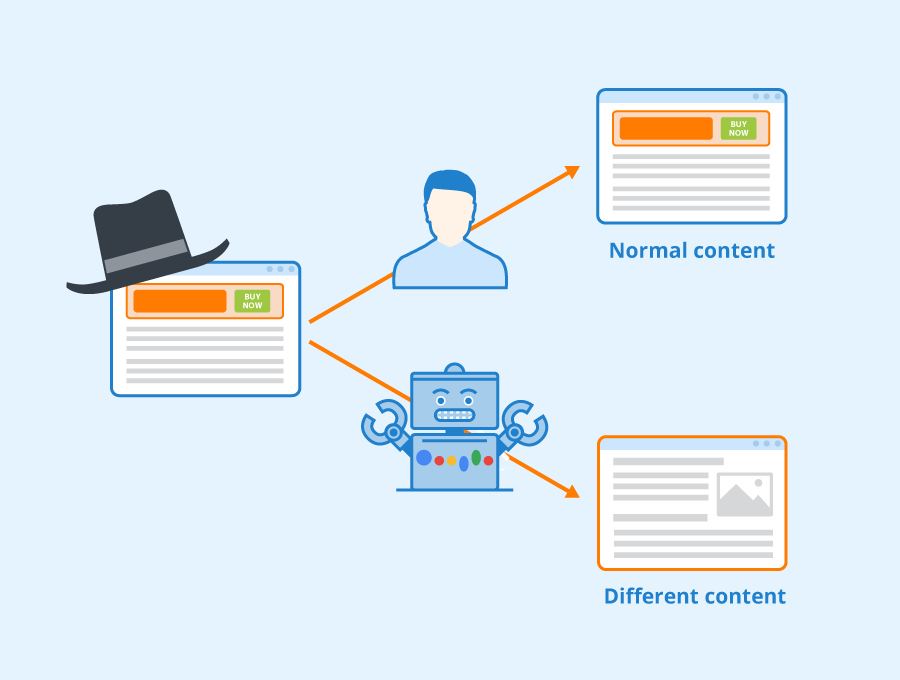Cloaking is a technique in search engine optimization (SEO) often referred to as ‘What is Cloaking in SEO? , where different content is presented to search engines and users. Essentially, it’s like showing two faces: one for the users who visit the website and another for search engines like Google. This method is used by some website owners to try to improve their site’s search engine rankings.
However, it’s important to note that cloaking is considered a “black-hat” SEO strategy. This means it’s against the rules set by search engines and can lead to serious consequences, including penalties. It’s a deceptive practice where the search engines are tricked into ranking content differently than how a user would see it.
In this article, we’ll break down what cloaking really is, explore its various forms, and discuss why it’s not a recommended practice. We aim to make this concept easy to understand, so you can be more informed about the right and wrong practices in SEO. Let’s dive into the specifics.
Table of Contents
What is Cloaking in SEO?
Cloaking is a dubious method in SEO (Search Engine Optimization) where a website displays one version of its content to search engines and a different version to actual visitors. Essentially, it’s like having two faces of a website: one optimized to rank higher in search engine results, and the other designed for real people who visit the site.
Cloaking is when a website shows one content version, ‘A’, to its users and a different version, ‘B’, to search engines.


What are the different types of cloaking?
Cloaking in SEO comes in several forms, each showing different content to search engines and users. Here’s a simplified breakdown:
- User-Agent Cloaking: Websites show varied content based on the web browser being used, determined by the browser’s user-agent string. The goal is often to optimize the user experience for different browsers.
- IP-based Cloaking: This involves displaying distinct website versions to users based on their geographic location, identified by their IP addresses. For example, a visitor in the USA might see a different site version than someone in England.
- JavaScript Cloaking: Here, JavaScript is used to present certain content to users, which remains invisible to search engines. It’s typically employed to provide dynamic, user-focused content.
- Hidden Text Cloaking: One of the more straightforward methods, involves hiding text on a webpage so that only search engines can detect it, not the site’s visitors.
- Referrer-based Cloaking: This technique varies the content shown to a user depending on the source website they arrived from. For instance, a user coming from YouTube may see different content compared to one coming from a Google search.
Each of these cloaking methods manipulates how content is viewed differently by search engines and site visitors, often contravening search engine guidelines.
What are Reasons to Avoid Cloaking in SEO
- Risk of Penalties: Engaging in cloaking can lead to severe penalties from Google, regardless of whether it was done knowingly. This can result in a significant drop in search engine rankings, potentially undoing all the effort put into your website.
- Difficulty in Recovery: Once penalized, it’s challenging to regain your previous search engine standing. The effort to clean up and recover can be extensive, and some websites may never fully recover.
- Possibility of a Ban: In extreme cases, Google might ban a website caught cloaking. Being removed from Google’s indexing means your site essentially becomes invisible in search results, drastically reducing its online presence.
- Likelihood of Getting Caught: Search engines, especially Google, are increasingly adept at detecting cloaking and other black hat SEO tactics. What might have worked in the past is likely to be identified and penalized now.
- Brand Damage: Cloaking can harm your brand’s reputation. Users don’t appreciate being deceived, and if they lose trust in your brand, they are less likely to return. This erodes the foundation of audience trust essential for brand building.
Easy Steps to Identify SEO Cloaking


To protect your website from the risks of cloaking, especially from unauthorized changes, use tools like SiteChecker and DupliChecker. Regularly test your website with these tools. If you notice any odd behavior or get unusual results, quickly locate and fix the problem to avoid penalties.
What is Google’s penalty for cloaking?
Google strictly prohibits cloaking as it breaks their Webmaster Guidelines. If caught, a website can be severely penalized, such as being dropped from Google’s search results or even getting banned entirely. The consequences of using cloaking are significant. To stay on the safe side, concentrate on creating valuable, relevant content that benefits both users and search engines.
Conclusion:
In summary, cloaking in SEO is a high-risk strategy involving showing different content to search engines and users. It’s a practice that can lead to serious consequences such as penalties and bans from Google, and it undermines the trust of your audience. Understanding the various forms of cloaking and the reasons to avoid it are crucial for maintaining a credible and successful online presence. Regularly checking your site for cloaking using tools like SiteChecker and DupliChecker can help you stay on the right track. Remember, the key to sustainable SEO success lies in creating authentic, high-quality content that serves and respects both your audience and search engine guidelines.
FAQs
Q. What is cloaking in SEO?
A. Cloaking is a technique where a website shows different content to search engines and its visitors. It’s like having two versions of your site: one for users and another for Google’s ranking purposes.
Q. Why is cloaking considered a bad practice in SEO?
A. Cloaking is seen as deceptive because it shows different content to search engines than to users. It violates search engine guidelines and can lead to penalties, including lower rankings or a ban.
Q. What are some common types of cloaking?
A. User-Agent Cloaking, IP-based Cloaking, JavaScript Cloaking, Hidden Text, and Referrer-based Cloaking are common types. Each shows different content based on the user’s browser, location, or referring site.
Q. How can I identify if my website is using cloaking?
A. Regular checks with tools like SiteChecker and DupliChecker can help identify cloaking. Look for discrepancies in content displayed to users and search engines.
Q. What are the risks of using cloaking in SEO?
A. The risks include severe penalties from search engines like Google, a drop in search rankings, difficulty in recovering your site’s standing, potential banning, and damage to your brand’s reputation.
Q. What should I do instead of cloaking?
A. Focus on creating high-quality, relevant content that serves both your users and search engines. Adhere to ethical SEO practices to build a sustainable and trustworthy online presence.




